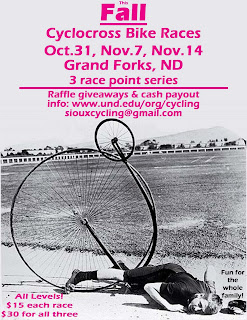Trips
Class credit?
Interest from students?
Publishing
Contact between chapters
Inspiration
Looking for Inspiration in the End of a Project
It’s the time of year again where I get a break from classes and from being in North Dakota in general, and get to go visit the folks for a few weeks and get some down time. “Down time” being, for a graduate student, the opportunity to get some serious work done without the distractions of classes, advisors, people down the hall, etc.
One of the projects I want to get mostly completed by the time I return in January is to produce two graphics based on literature and museum data concerning my family-level taxon of study. The first of these will be a range chart of the fossil and modern genera (if not species…we’ll see), the second a map showing where all of these taxa can be found. To the commonfolk (i.e., anyone who has never tried this before) this might seem easy, but it’s really going to take a lot of digging through old papers, searching PDFs, and racking up a heck of a list for interlibrary loan next semester. I rediscovered earlier this week that although there may be a lot of information out there on my taxon, some authors didn’t do the best job of organizing what they knew.
Now, you might ask me why I want to use a great deal of my “break” time to do research. The first reason is that I would like to graduate somewhat soon, and the time for, well, wasting time is over. The second reason is something I had to come up with myself for motivational purposes: I want to help people understand things, and to do that I need to be able to make good graphics.
“Infographics” have been the hot new thing for a couple years now, and Tufte will tell you over and over again that you need to include what data are needed and eliminate the stuff that doesn’t matter. I would also argue that things need to be aesthetically pleasing to be educational, something to which I attribute the use of such soothing colors in introductory textbook diagrams. The point I am trying to make is that I need practice in this area, and I might as well practice now, at the beginning of my dissertation, than at the end when all I will want to do is hand-scribble a diagram, scan it, and call it good enough to hand in.
Optimally, my goal is to make these figures (my range diagram and global distribution map) not only good enough to include in a peer-reviewed journal article but good enough to print out as posters and hang on the wall! This is the goal toward which I am striving: I want someone in a similar research area to be able to use my work as a visual reference, and I want someone who has no clue about my research area to be able to look at it and say “oh yeah, I see how this can be useful.” For a great example, see the “Unionoida cum Grano Salis” poster from the Mussel Project.
Goals like “aesthetically pleasing” and “understandable” are intangible and hard to quantify, but that’s also not the entire point–sure, I’ll be happy to get as close as I can, but my real reason is the second motivation I listed above. If I can picture the future where I’m done with the figures, they look good, and I publish them so others can use them, it makes the drudgery of collating occurrence data that much more bearable–and if that is what gets good science done, let’s do it.
Ride in the snow
First winter training ride 2010/2011
[EDIT: My winter riding setup has changed quite a bit since this post. The basics are there, but I’ve upgraded pretty much all of my clothing, requiring me to wear fewer, lighter layers. I’ve replaced the bicycle (won a Pugsley frame at a race), upgraded the lighting, and gone to flat pedals with Power Grips combined with Muck boots for my feet. 2014-02-05]
I just got back a while ago (:-P) from my first “official” training ride of the winter season. It snowed the weekend before Thanksgiving, but I was returning from the Smithsonian and missed out on the freshie powder, then was busy all week aside from commuting. This evening I finished what I was doing in time to get some real training in.
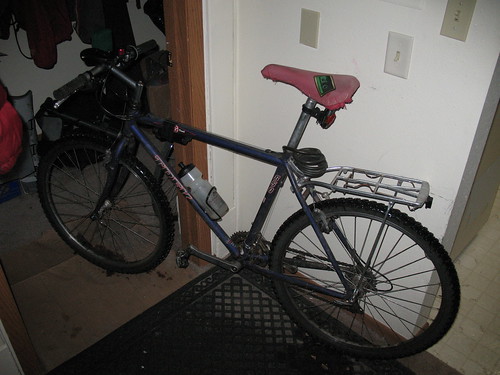 |
| (All You Haters Stud My Tires) |
The temperature when I returned (a little before 7 PM) was 17 F (-8 C), so it’s balmy by Grand Forks standards (or it will be by March!). There was an 11 MPH (17 km/hr) breeze from the north, but it definitely (to my out-of-shape body) felt like a lot more than that. I did the pedestrian bridge loop (to north bridge to south bridge and back) on my mountain bike, following the Greenway path. The path is nicely plowed for the most part, so much so that once my light died I could still see well enough to not endo over any piles of snow kicked up by the snowmobiles (the clear sky may have helped in this regard; nothing like following a black ribbon through a white wilderness).
As I said, the wind being from the north I got a bit of a workout, followed by a long period of speed, followed by my realization that I had forgotten how much of a workout I’d had at first, once I got to turn back into the wind. The weather was nice, and I think I dressed appropriately, which is always something of a challenge for me. I tend to run hot, which up until recently has resulted in me winding up drenched by the time I get to school since I wear a down jacket. I finally bought a clip-on pannier/shopping bag that I can throw my messenger bag into and not have to carry it on my back, so it’s much easier to regulate my temperature while commuting.
Anyway, back to tonight: the image below shows what I was wearing, with a list in case people are interested. I was warm enough with the tailwind, but the headwind sections were somewhat chilly on the knees and arms. I tried out vapor barriers for my feet for the first time since I have chronically cold toes in the winter; they may have worked, or it may have been too warm for me to feel the difference. Any time I can step off the bike and not feel like I’m standing on two frozen lumps of flesh is a good day.
 |
| (All You Haters Wash My Shorts) |
“RED” snowboarding helmet (from Play It Again Sports)
Smith goggles and neckwarmer (from Ali!)
bike shorts from inside baggy mtb shorts
Teko socks from END-AR 2009
plastic bags from phonebooks
cheap Nike mtb shoes
wool mittens (knitted by Mum) inside Swedish mitts from Midwest Mountaineering
North Face fleece (from Ali’s parents)
Cloudveil pants (from Ali)
Under Armour coldgear shirt (from a guy I ran with at SLU)
My other equipment could use an upgrade (maybe someone could b[u]y me this?), especially my front lighting system. I bought this light when I first got my mountain bike in eighth grade (thankfully the frame has proven large enough!). It runs a single incandescent bulb, I have no idea what the candlepower is, and uses 4 D batteries. It also seems to be having a lot of trouble in the cold this year 🙁
 |
| (All You Haters Velcro My Batteries) |
Since I’m trying to limit the whole blog post production time (BPPT) to a half-hour or less, I’ll only throw up one more photo of my new camera sweater. I’m not sure it works to keep things warm so the batteries last longer, but my buddy Mario (now Cat 2 road, congrats!) uses a similar setup for his power meter, and considering he’s an electrical engineer, it can’t have deleterious effects. I’ve been taking some decent winter commuting videos, so hopefully they’ll make it up eventually.
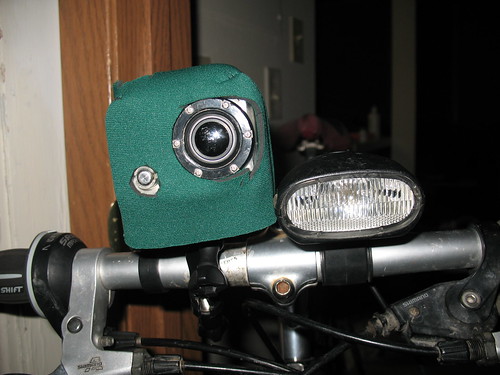 |
| (All You Haters Sweater My Camera) |
Happy riding!
Ride distance: 16.2 km
Ride time: 45:11
Average speed: 21 km/hr
Trouble-Free Upgrading Between Opera Nightly Builds in Mac OS 10.6
(If you can’t tell from the title, I’ve been reading too much Lifehacker lately.)
As alluded to before, I’ve been using Opera for a month or so now because Camino decided it was going to suck down all my CPU. Since only the nightly build at the time had the feature I wanted (bookmark bar, works well so far), I was forced to travel into “the land of no automatic updates.” Fortunately, I figured out how to keep all of my settings, bookmarks, and even open tabs when upgrading. Note that these steps may not be necessary, since everything might end up hunky-dory all by itself.
Steps:
1. You’re probably getting your nightly builds from here. Why they use a blog (with anonymous commenting disabled, no less) for getting feedback on builds is beyond me. In any case, you should download the nightly you want to use.
2. Back up your bookmarks and your ~/Library/Preferences/Opera Preferences * folder just in case. You can also move your current Opera application bundle out of Applications and onto the desktop just in case.
3. Install the new version by opening the DMG and dragging the application bundle to your Applications directory. Don’t start the browser yet.
4. Copy the files you backed up from your Opera Preferences folder into the most recent Opera Preferences folder (there might be a version change which changes the folder name; just today I went from 10.7 to 11.0 on the folder name even though I’m using the last build of 10.
5. Start Opera (the new version). Hope things work.
Hope this helps somebody, or at the very least sets them on the right track.
Life as a Race/Event Coordinator
I was recently (last month) elected to be the Race/Event Coordinator for the UND Cycling Club. This is a position I’ve more-or-less held in some capacity for the past few years, since I’ve been trying to get more events happening ever since I got hooked up with the club back in 2008. Now that I can someday put this on my resume (ha!), I’m taking it more seriously, but at this point I’m receiving more help than opposition than any time in the past.
I intend to add “event coordinating” to the list of things I blog about here. Over the next year you will be subjected to the problems I encounter, the triumphs of successfully navigated paperwork, and hopefully even some good feedback about what else can be done in Grand Forks for this organization and others.
One of my inspirations in this pursuit is Andy Magness, director of END Racing, choreographer of the only adventure racing in the state, and top-notch yoga instructor. If I can get to the point where I can orchestrate an event with half the participants, half the sponsors, half the press, and half the general excitement surrounding it of any of the events Andy has organized over the last few years, I’ll be flying high.
As someone who is naturally not outgoing, event coordinating is a big deal to me for that reason: I have to interact with people, I have to know what’s going on, and I have to think of things nobody else does, answer questions that nobody would ever come up with, and do it all with volunteers who would much rather be racing than volunteering (but we’re working on that this year; I’m committed to this role, even if it means I don’t get to participate in the ‘cross series [beginning Halloween in Riverside Park], the icebike series [announcement coming soon!], or even another collegiate road race weekend).
Most importantly, I need to be able to take the (sometimes nebulous) ideas presented by club members and turn them into a workable event. The best mind we’ve had for this is Dave Cardarelli, who will finally be graduating this December. Whether we’ve been organizing UND’s 2010 NCCCC road race weekend (complete with conference criterium championships), alleycat races that aren’t boring, or Grand Forks’ first ever (?) icebike race, Dave has either known what to do or shouted the rest of us down when we disagreed, which generally amounts to the same thing. Now that I’ve got this role on my shoulders, I hope I can measure up.
So far this fall I’ve been in contact with more people than ever to get some last-minute fall events into place and think about the future:
- We’re starting a three-race cyclocross series (UND’s Fall Classic, to be expanded next year) on Halloween. Instrumental in the planning of this race so far have been my geology colleague Ted Bibby as well as Dave; so much so that I have yet to visit they race course they’ve supposedly devised, even though I’ve delivered a map to the city with our request for a special events permit.
- For the long term, I’ve been working with riders in Fargo, Sioux Falls, and Winnipeg to organize a winter icebike series next February, as well as keeping in contact with Andy Magness to make sure we won’t interfere with END-IT (which as scheduled stands to be the light at the end of the tunnel of a month of winter racing if all goes to plan).
- It hasn’t been nailed down yet whether we’ll be hosting “Too Flat, Too Furious” again next spring, but if our roster expands as much as I hope it will, we shouldn’t have a reason not to (more riders, in my mind, means a larger volunteer pool and more people invested in making sure the event goes off without a hitch). We’ll be talking about this down the road as people start dropping like flies around January.
- We failed to organize a late summer mountain bike series this year (although getting a ‘cross series in before the snow is a nice bonus), but I hope to get it rolling for sure in mid-August: six weeks of mountain bike racing at Turtle River State Park followed by six weeks of cyclocross (which could alternate between TRSP and the Grand Forks Greenway, to say nothing of finding a friendly farmer who will let us use a cornfield).
- Beyond? Well, let’s not get ahead of ourselves 🙂
As a final note, this isn’t about me: it’s about the club and what we can do for people in Grand Forks. Cycling, running, and even adventure racing events have been on the rise since I moved here in January 2006. I intend to make this trend continue, so if you have any ideas for events, improving events, or collaborating, get in touch.
From Landscape XYZ Point Data to *.STL to Rapid Prototype (part I)
Considering I haven’t sent the finished model to be vetted by the Professor who runs the rapid prototyping machine, this can only be the first part of hopefully a short series.
To continue my quest to use laser scanning to model and then reproduce important fossils, I was given a sample dataset to format correctly and then send over to the Mechanical Engineering Department to test out their rapid prototyping machine. This dataset is a landscape model (I believe based on a DEM) made of point data in an XYZ file. To explain, the surface is made up of a series of points positioned by x-axis, y-axis, and z-axis triplets. In the end, I needed a solid model in *.STL format. Although I was told to use AutoCAD for this, I think I’ve found another (free) way.
I planned to import the data file into the free, open-source point-meshing program Meshlab v. 1.2.3 and manipulate it there, but I needed to change the file format correctly first. Originally, I used the MS-DOS program xyz2vrml.exe (from this useful site) to convert the data text file into a *.WRL (VRML) file, but then I realized I could just change the file extension and Meshlab would be able to read and import the points (this of course only works if your data file just has a different extension than Meshlab expects, not if the data are a different type).
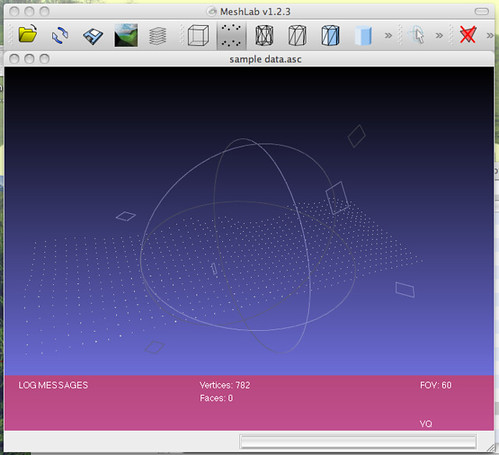 |
| Adding point landscape data to Meshlab. |
To convert the point data to a mesh (TIN) surface, I used the Surface Reconstruction: Ball Pivoting filter (in the Remeshing, simplification and reconstruction menu) with the default settings (world unit: 0.0, perc on 0.0, clustering radius: 20, angle threshold: 90). To see the result I had to click the Wireframe button in Meshlab to get a surface made of triangles. The file was saved in *.3DS format.
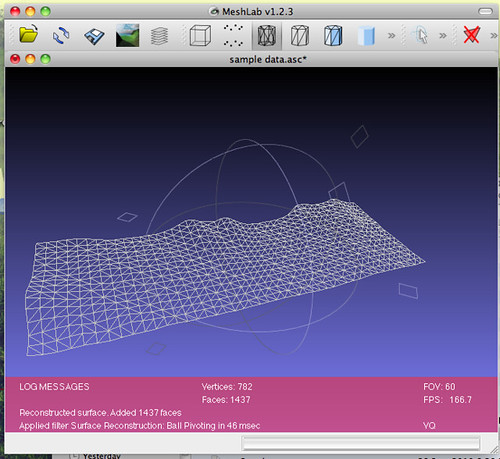 |
| Wireframe after meshing. |
The *.3DS file was then imported into Google Sketchup for modeling. Although the mesh seemed to act like a single object, attempting to use certain tools made me realize that it was being manipulated as a collection of triangles, which meant I couldn’t use such things as the Push/Pull tool to extrude the surface down to a lower plane to create a solid model. Luckily I found a Sketchup plugin to let me do something similar (available here). The Curviloft plugin allowed me to fill in space between a rectangular base (easily drawn in Sketchup) and the meshed landscape surface above it.
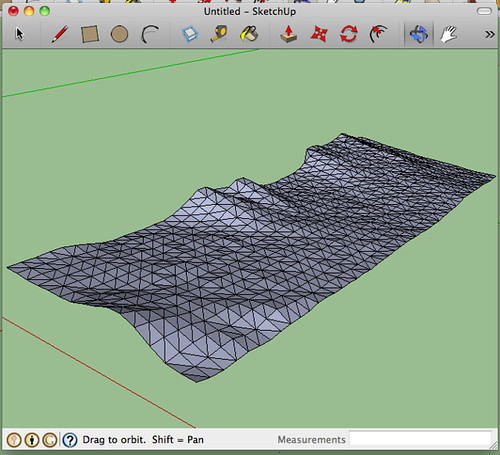 |
| Adding mesh to Google Sketchup. |
I used the Skin Contours tool on each of the four remaining sides to achieve a solid model. To do this, I drew a line connecting the corner of the base rectangle to the corner of the mesh above it. Once a side had been marked this way, I used the Skin Contours tool to select each edge of what the new face was going to be and clicked the checkbox. In order to select adjacent mesh edges, the Extend Selection toolbar button needed to be on, and the Stop Prolongation button needed to be off.
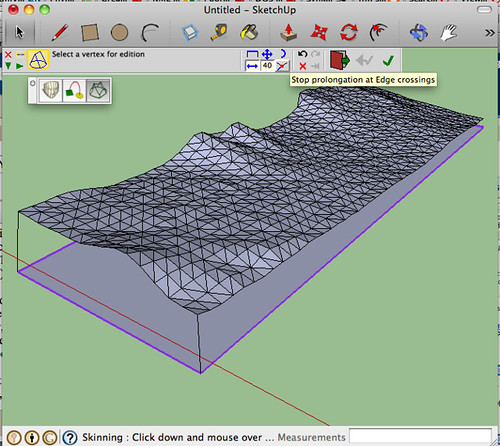 |
| Adding a base and connecting it to the mesh at the corners. |
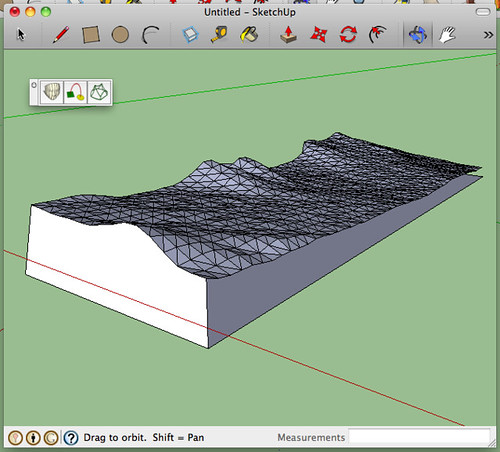 |
| One side completed. |
To get the final file format correct (I’m hoping), I had to export the model from Sketchup as a COLLADA (*.DAE) file, then into Meshlab, and then use Meshlab to save into *.STL. I was told that my *.STL file needs to be “solid,” but I’m not sure whether this simply means “no holes” or whether there is a trick to completely fill the model with some virtual material (Unobtanium? Adamantium?). I’ll send this model to the Professor of Rapid Prototyping (not his real title, unfortunately) and see what sort of feedback he has. Tune in next time for the exciting conclusion!
 |
| The finished model in Google Sketchup. |
Total project time (including learning Sketchup and Meshlab and designing the workflow): several hours.
Writeup time: 1.5 hours
[activity] 2010 North Dakota EPSCoR Conference
I attended the 2010 North Dakota EPSCoR (Experimental Program to Stimulate Competitive Research) Conference yesterday to see the work of some of my fellow students, but did not submit a poster. There is a good summary here.
UND Geology and Geological Engineering presenters:
– Ted Bibby and Jaakko Putkonen – Landscape evolution of ice free valleys, central Antarctica
– Nic Buer and Phil Gerla – Comparison of nutrient transport and concentration between an invasive-dominated, disturbed wetland and a natural sedge meadow wetland in northwestern Minnesota
– Chase Christenson and Scott Korom – Denitrification at the Oakes Irrigation Test Area, Dickey County, ND
– Rob Klenner and Will Gosnold – Reevaluating terrestrial heat flow in Minnesota
– Risa Madoff, Ted Bibby, Megan Miller and Jaakko Putkonen – Hillslope evolution quantified with digital laser scanning in eastern Sierra Nevada, CA
– Megan Miller, Risa Madoff, Ted Bibby and Jaakko Putkonen – Photo analysis of landscape change in the eastern Sierra Nevada mountains, California
– Karew Schumaker, Matt Weiler, Joseph Hartman and Allen Kihm – Geology and preliminary paleontology of the Cvancara locality (Paleocene), Tongue River Member of the Fort Union Formation, Grant County, North Dakota
– Vladimir Zivkovic and Will Gosnold – A multiple method geophysical investigation of the northeastern rim of the St. Martin impact structure, Manitoba, Canada
Other posters of note (among many)
– Janna Mabey and Becky Simmons – Phylogeny and generic revision of the Tiger Moth genus Phoenicoprocta (Noctuidae: Arctiinae: Euchromiina) for use in examining the evolution of male courtship signals
– Andy Magness, J.M. Hicks, C. Desgranges and J. Delhommelle – Phase equilibria of polyaromatic hydrocarbons by Hybrid Monte Carlo Wang-Landau simulations
ND EPSCoR State Conference 2010 in Grand Forks
I spent this morning and early afternoon at the North Dakota EPSCoR 2010 State Conference. EPSCoR (Experimental Program to Stimulate Competitive Research) is a federally funded program to fund states that need additional infrastructure in order to improve their research output. It is funded competitively, and then those funds are distributed within the state towards research projects, facilities, and scholarships. I learned today that North Dakota is the only state that has been funded continuously since the program’s inception in the early 80s. Part of this is supposedly because the state agrees up front beforehand to match the federal money given, something I guess other states aren’t able to do.
The posters (graduate student research projects) were generally very good, although a lot of walking was involved to see everything because of placement on the walls down the main corridor of the Alerus Center. Several of my Geology and Geological Engineering colleagues presented posters, most of them luckily in high-traffic areas. A lot of the material was biochemical in nature, which tended to make me (since I’m not a chemical biologist) gloss over some things I probably shouldn’t have; I would suggest to EPSCoR that in the future the posters be arranged more according to topic, which might have the added benefit of getting students from different institutions to talk to each other about their similar topics.
I’ve scanned the poster session program (includes abstracts), and for general entertainment I shot some photos, shared below.
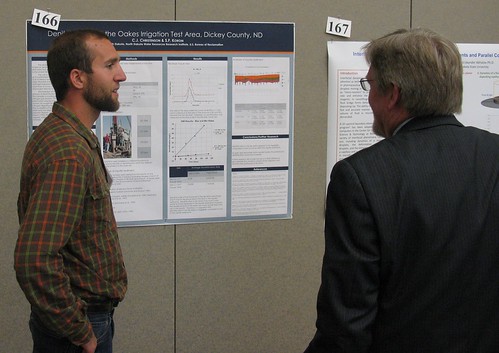
A geologist explains his project.
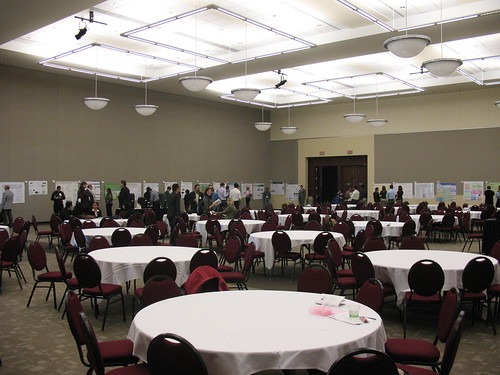
Breakfast, the introductory speaker, and some of the many posters were on display in this room.
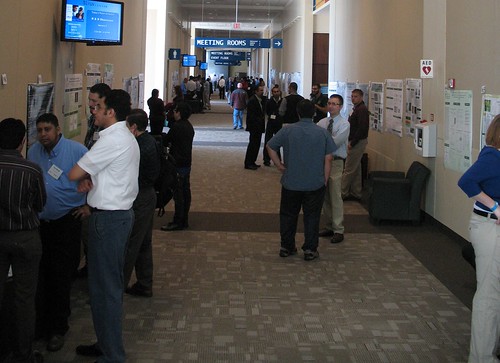
Student posters went all the way down the hall.
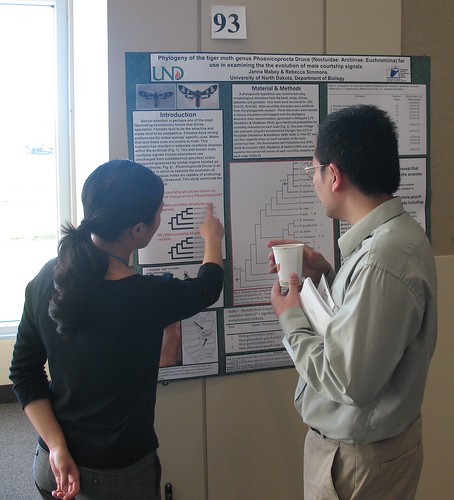
A biologist explains her work.

Lunch was surprisingly good for being free.
To do: make sure I have a list here of all the GGE students who presented.
Problems with Tiddlywiki with Opera 10.70 (build 9047) for Mac
At some point in the last few days (actually it looks like since the 18th of September), Opera has quit being able to save my TiddlyWiki files–in fact it appears that all the notes I made for my dissertation on Monday have disappeared, even though I thought I was autosaving. I’m more than slightly miffed about this.
At present, it looks like TiddlyWiki works fine in Safari and Camino (the browser from which I just switched because it uses up most of my CPU). In Opera, however, I get this error:
The original file ’empty.html’ does not appear to be a valid TiddlyWiki
and the file will not save. For some reason, the dialog box asking for permission for the security certificate has also stopped appearing, while in other browsers it comes up for each new TiddlyWiki file I open.
I’ve looked into this as much as I wish but I cannot find a solution. The problem may be with Java (somehow?), or with this particular build of Opera (I think I am on a nightly build because I wanted some of the new functionality). In any case, I’m stymied by the lack of ability to really manage the security certificates, especially when they don’t pop up. I’ll be using Safari as my TiddlyWiki browser until I figure out what the issue is or things suddenly start working again in Opera.



